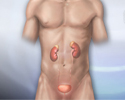Urinary incontinence - tension-free vaginal tape
Retropubic sling; Obturator sling
Placement of tension-free vaginal tape is surgery to help control stress urinary incontinence. This is urine leakage that happens when you laugh, cough, sneeze, lift things, or exercise. The surgery helps close your urethra and bladder neck. The urethra is the tube that carries urine from the bladder to the outside. The bladder neck is the part of the bladder that connects to the urethra.
Description
You have either general anesthesia or spinal anesthesia before the surgery starts.
- With general anesthesia, you are asleep and feel no pain.
- With spinal anesthesia, you are awake, but from the waist down, you are numb and feel no pain.
A catheter (tube) is placed in your bladder to drain urine from your bladder.
A small surgical cut (incision) is made inside your vagina. Two small cuts are made in your belly just above the pubic hair line or on the inside of each inner thigh near the groin.
A special man-made (synthetic mesh) tape is passed through the cut inside the vagina. The tape is then positioned under your urethra. One end of the tape is passed through one of the belly incisions or through one of the inner thigh incisions. The other end of the tape is passed through the other belly incision or inner thigh incision.
The doctor then adjusts the tightness (tension) of the tape just enough to support your urethra. This amount of support is why the surgery is called tension-free. If you do not receive general anesthesia, you may be asked to cough. This is to check the tension of the tape.
After the tension is adjusted, the ends of the tape are cut level with the skin at the incisions. The incisions are closed. As you heal, scar tissue that forms at the incisions will hold the tape ends in place so that your urethra is supported.
The surgery takes about 2 hours.
Why the Procedure Is Performed
Tension-free vaginal tape is placed to treat stress incontinence.
Before discussing surgery, your doctor will have you try bladder retraining, Kegel exercises, medicines, or other options. If you tried these and are still having problems with urine leakage, surgery may be your best option.
Risks
Risks of any surgery are:
- Bleeding
- Breathing problems
- Infection in the surgical cut or the cut opens up
- Blood clots in the legs
- Other infection
Risks of this surgery are:
- Injury to nearby organs - Changes in the vagina (prolapsed vagina, in which the vagina is not in the proper place).
- Damage to the urethra, bladder, or vagina.
- Erosion of the tape into surrounding normal tissues (urethra or vagina).
- Fistula (abnormal passage) between the bladder or urethra and vagina.
- Irritable bladder, causing the need to urinate more often.
- It may become harder to empty your bladder, and you may need to use a catheter. This may require additional surgery.
- Pubic bone pain.
- Urine leakage may get worse.
- You may have a reaction to the synthetic tape.
- Pain with intercourse.
Before the Procedure
Tell your health care provider what medicines you are taking. These include medicines, supplements, or herbs you bought without a prescription.
During the days before the surgery:
- You may be asked to stop taking aspirin, ibuprofen (Advil, Motrin), warfarin (Coumadin), and any other medicines that make it hard for your blood to clot.
- Arrange for a ride home and make sure you will have enough help when you get there.
On the day of the surgery:
- You will likely be asked not to drink or eat anything for 6 to 12 hours before the procedure.
- Take the medicines you were told to take with a small sip of water.
- Your provider will tell you when to arrive at the hospital. Be sure to arrive on time.
After the Procedure
You will be taken to a recovery room. The nurses will ask you to cough and take deep breaths to help clear your lungs. You may have a catheter in your bladder. This will be removed when you are able to empty your bladder on your own.
You may have gauze packing in the vagina after surgery to help stop bleeding. It is most often removed a few hours after surgery or the next morning if you stay overnight.
You may go home on the same day if there are no problems.
Follow instructions about how to care for yourself after you go home. Keep all follow-up appointments.
Outlook (Prognosis)
Urinary leakage decreases for most women who have this procedure. But you may still have some leakage. This may be because other problems are causing your incontinence. Over time, some or all of the leakage may come back.
References
Gomelsky A, Dmochowski RR. Slings: autologous, biologic, synthetic, and midurethral. In: Partin AW, Dmochowski RR, Kavoussi LR, Peters CA, eds. Campbell-Walsh-Wein Urology. 12th ed. Philadelphia, PA: Elsevier; 2021:chap 125.
Walters MD, Karram MM. Synthetic midurethral slings for stress urinary incontinence. In: Walters MD, Karram MM, eds. Urogynecology and Reconstructive Pelvic Surgery. 4th ed. Philadelphia, PA: Elsevier Saunders; 2015:chap 20.
Review Date: 1/10/2021
Reviewed By: Kelly L. Stratton, MD, FACS, Associate Professor, Department of Urology, University of Oklahoma Health Sciences Center, Oklahoma City, OK. Also reviewed by David Zieve, MD, MHA, Medical Director, Brenda Conaway, Editorial Director, and the A.D.A.M. Editorial team.


